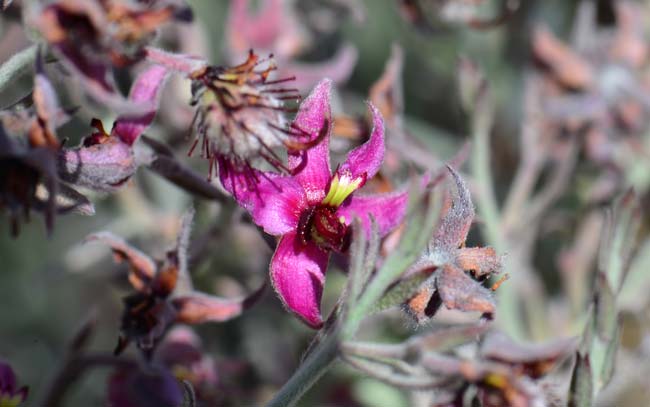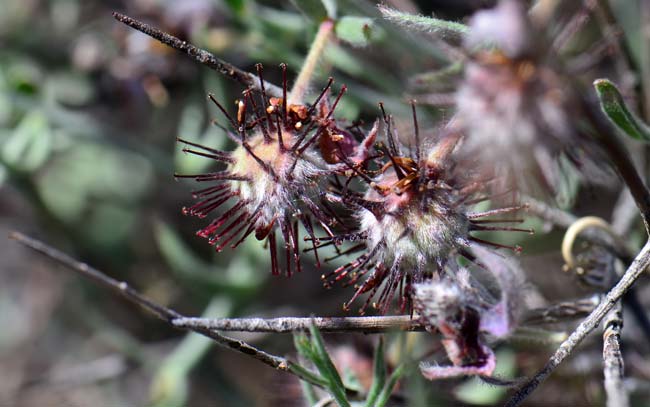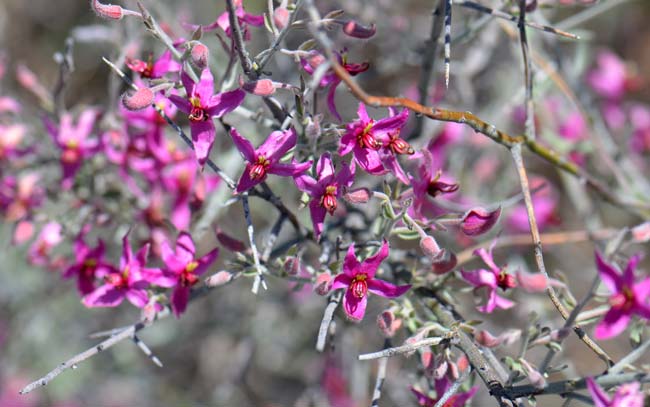Krameria bicolor, White Ratany




Scientific Name: Krameria bicolor
Common Name: White Ratany
Also Called: Crimson Beak, Range Ratany, White Rhatany; (Spanish: Cósahui, Cósahui (Casahui), Guisapol Colorado, Mezquitillo, Chacaté, Mamelique)
Family: Krameriaceae, Ratany Family
Synonyms: (Krameria canescens, Krameria grayi)
Status: Native
Duration: Perennial
Size: Up to 2 or 3 feet.
Growth Form: Shrub/subshrub; photosynthesizing root parasite, plant color variable from gray-green to whitish-gray, densely branched, canescent, branches with soft spiny tips.
Leaves: Green, gray-green or whitish-gray; alternate, deciduous, pubescent, small, narrowly lanceolate.
Flower Color: Purple, purple-red or reddish; buds are curved upward, sepals reflexed, flag petals free, glandular petals vertical, purple, fruit is mostly globose and spiny, spines with recurved barbs at tip, fruit canescent or strigose, globose.
Flowering Season: April to September.
Elevation: Up to 4,000 feet, usually observed at lower elevations.
Habitat Preferences: Dry, rocky, sandy and lime soils in desert shrub communities.
Recorded Range: Krameria bicolor is found in the arid regions of the southwest in the states of; AZ, CA, NM, NV, TX and UT. It is also native to Baja California and Mexico. In Arizona it is found in the western, central and south-central parts of the state.
North America & US County Distribution Map for Krameria bicolor as Krameria grayi.
U.S. Weed Information: No information available.
Invasive/Noxious Weed Information: No information available.
Wetland Indicator: No information available.
Threatened/Endangered Information: No information available.
Comments: Similar to one of its closest relative the Littleleaf Ratany (Krameria erecta), White Ratany produces oil instead of nectar that attracts bees of the genus Centris which have specialized hind legs enabling the bee to scrap up the oil. Ratanies photosynthesize but are root parasites able to obtain nutrients, including life-saving water, from nearby plants such as Creosote bushes.
The family Krameriaceae has been taxonomically shuffled around between several families including Fabaceae and Polygalaceae.
White Ratany is similar in appearance to Littleleaf Ratany (Krameria erecta). Common differences vary across the range of these species and key characteristics in technical journals are not completely reliable. A good distinction between the two species is the shape and spines of the fruit. In White Ratany the fruit is much more globose compared to the heart-shaped compressed fruit of Littleleaf Ratany and the spines on the White Ratany are barbed at the tip and the tip of Littleleaf Ratany does not have a hooked barb. However both species may also have barbs scattered about the spines. Another good characteristic is the shape of the flower buds which are curved upward on White Ratany.
The family Krameriaceae and genus Krameria are named in honor of the father and son Austrian botanists Johann Georg Heinrich Kramer (1684-1744) and Henry Kramer (1765).
In the Sonoran Desert, Krameria grayi has high wildlife value for Mule Deer, Desert Bighorn Sheep and Black-tailed Jack Rabbits. It is also important forage for livestock.
White Ratany was used by the Paiute’s as a dermatological aid, a disinfectant and as an eye medicine and by the Pima’s as an analgesic and cough medicine. See ethno-botanical uses at Native American Ethnobotany, University of Michigan, Dearborn.

